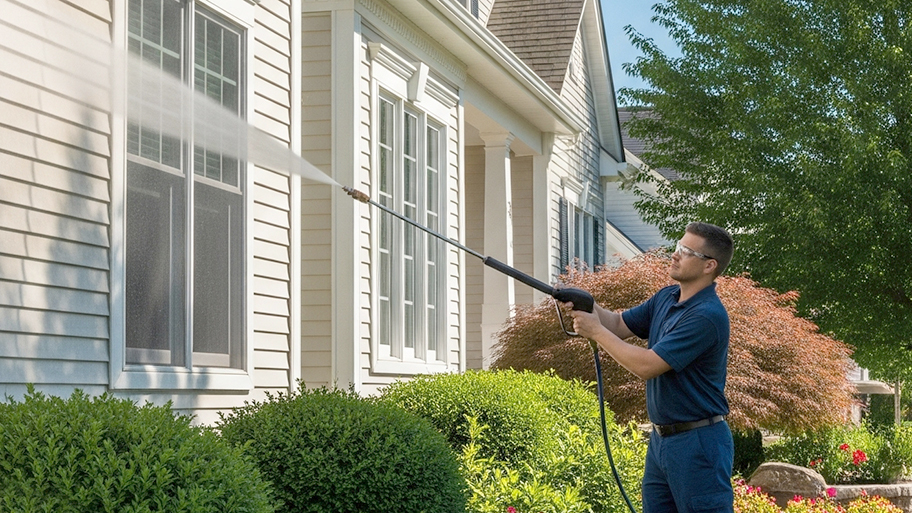
Need to breathe new life into your dirty siding and trim? Explore the cost to pressure wash a house to boost your curb appeal instantly.
Yes, you can pressure wash wood, but choosing the right amount of pressure is key


Pressure washing uses highly pressurized streams of cold water for cleaning.
You can use a pressure washer to clean wood, but with caution.
Use lower pressure for softer woods, like cedar.
From siding and fences to decks and gazebos, your home likely has its fair share of wood. Part of the normal upkeep of wood is cleaning it to remove the buildup of dirt, grime, and mildew. While there are numerous heavy-duty cleaners on the market, you may ask if you can pressure wash wood for a faster and more effective result.
The answer is yes, you can pressure wash wood, but if you’re unsure of what type of wood you’re dealing with or how to use the equipment, then you may consider hiring a professional. Here’s what you need to know before you start spraying.

Pressure washing wood speeds up the necessary process of cleaning it from all the elements it’s exposed to and is great for prepping the wood ahead of staining. It requires equipment that spouts out cold water in a concentrated stream, measured by the force of pounds per square inch or psi. Because of the amount of pressure applied, it’s important to work cautiously to prevent damage or personal injury.
There are a few things to keep in mind about how to properly pressure wash a deck or other parts of the home before you break out the machinery:
It’s less gentle versus soft washing. As the name suggests, pressure washing involves high amounts of pressure without the use of chemicals. Soft washing uses less pressure but needs detergent—which may be a more appropriate choice for your type of wood.
The amount of pressure depends on the type of wood. For softer woods, such as cedar and pine, the maximum amount of pressure recommended is 600 psi. However, heartier woods can withstand up to 1,500 psi.
You can accidentally cause damage if the pressure is too high. Not only must you consider the softness of the wood you’re pressure washing, but the distance and angle from which you spray. Keep the water about 16 inches away from the wood to start.
You don’t need additional cleaners. A cleaning solution isn’t required for pressure washing, but you can use it if you have particularly tough stains to treat.
Time of year matters. Pressure washing in the spring is ideal because you get rid of the grime and buildup from the winter, and the sun will speed up the drying process. You can pressure wash up until fall if needed, as long as the cold weather hasn’t set in yet.
Soft washing is the gentle cousin of pressure washing. It uses lower pressure for washing, which means you can use it on a variety of surfaces. It also generally includes a biodegradable chemical for removing elements like mold, dirt, and algae. It’s gentle enough for removing stains on surfaces such as wood panel siding, fences, and cedar shake. If you’re concerned about too much pressure on your wood surface, consider soft washing versus pressure washing.
You may hear “pressure washing” and “power washing” used interchangeably, but in fact, these are two different applications. Both use highly pressurized water for cleaning, but the difference with power washing is it uses hot water instead of cold. Because of the added heat, power washing is appropriate for only the most durable surfaces, like concrete driveways and patios, and is not recommended for wood.

The cost to pressure wash a house or cost to pressure wash a patio, for example, depends on if it’s a DIY project or if you hire professionals. To rent the equipment yourself, it’ll cost from $35 to $175 per day. If you prefer buying the equipment, most pressure washers cost $100 to $1,000.
For those that would prefer to hire a professional, the average cost of pressure washing is $0.10 to $0.50 per square foot. Pressure washing wood does require using some serious machinery, and even though it’s a relatively easy task, it’s a lot of manual labor, and inexperienced DIYers can cause costly damage. In many cases, it’s best to leave it to a professional pressure washer near you so you know it’s done the right way.
From average costs to expert advice, get all the answers you need to get your job done.

Need to breathe new life into your dirty siding and trim? Explore the cost to pressure wash a house to boost your curb appeal instantly.

The cost to pressure wash a house in Los Angeles, CA, is based on the project type and surface area. Plan your budget here.

Pressure washing your fence can restore its appearance and keep your home looking great. Learn how much it costs based on factors like square footage and material.

In many cases, pressure washing before painting is helpful, but it’s not always appropriate. Use this guide to learn whether to power wash your house before painting.

A leak can damage a pressure washer and cost more money in fuel. What would cause a pressure washer to leak oil? Find out the six top causes with this guide.

When comparing the types of pressure washer nozzles for your project, the right one depends on how concentrated you need the stream of water.